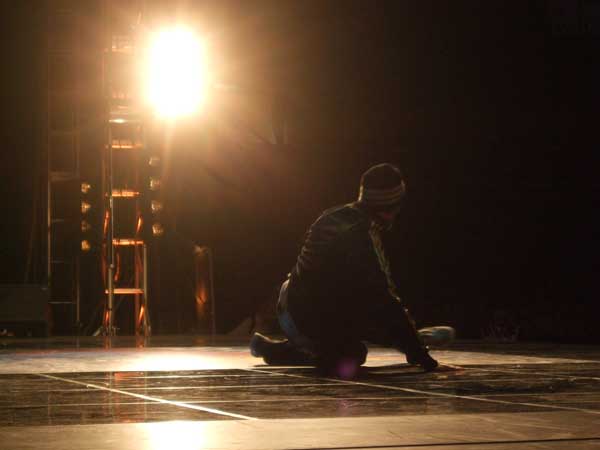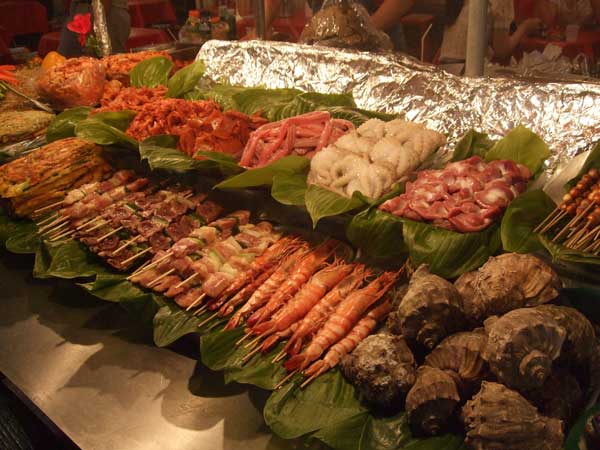
I had the opportunity to check out the R-16 (R = Respect) festival last year in Suwon, just outside of Seoul, Korea. I haven’t been to many breakdancing contests. OK, that was my first one. It didn’t take much, though, to realize that the event is bringing a level of legitimacy to an artform that is slowly inching its way towards Korean pop culture. Ground zero for the festival was Suwon City Olympic Park, home to the 24th Olympic games. The festival was spread out over two days, the park—turned-somewhat-arts center—was broken down into a few different areas. Graffiti crews outside putting their scrawl on a wall that stretched out hundreds of feet. The small outdoor stage to the right had a DJ and a pop & lock competition. Huge mats of linoleum were laid out under the basketball courts where teams practiced and the dropped-jaw local kids watched.
This years’ event runs from September 19th to 27th at the Incheon Culture & Arts Center Square. As with last year, there will be 16 teams representing 15 countries (Korea has two teams) competing for the title of World Champion. The festival, the city… the whole week was pretty fucking fantastic.
Make the jump to continue reading about my adventure in Seoul…

I’ve been to Seoul a few times and I’ve never been disappointed. It’s definitely a city of contrasts. Whether you’re getting lost in old Seoul in places like Namdaemun Market, a historic shopping district in the center of Seoul. If you’ve ever been you know that place is discombobulating—every inch of that place is taken advantage of. It’s 10 square blocks of stall after stall, each booth almost indistinguishable from the next: linen, cotton, wool, leather, fur, socks—Prada and Gucci at the bargain price of 3 for $5, no less. Merchants, competing with their neighbors, cry out as you pass by, urging you to take advantage of their cheaper prices. Huge underground catacombs lie beneath with even more sale goods. If you’re not ok with bad smells, don’t breath. The air is ripe with garbage juice—the kind of odors that wake up your senses and linger in the back of your throat long after the smell has dissipated. Around each corner is another artery of alleyways filled with venders hawking more of the things you just turned the corner from. I think I saw that old guy from The Golden Child—the short one with the weird eye. You know…dude that turns into the bird. I can’t be sure, though. His head was barely visible from over the top of the rolls of silk he was selling.
I’m told when you eat a live octopus that they frantically try to latch on to the sides of your throat in an attempt to, well, not die. Like most international markets, food here is abundant and strange. No hotdogs, hamburgers and pretzels. Think Anthony Bourdain, No Reservations style. Each alley seemed to have a makeshift restaurant with people sitting on stools snacking on unidentified pan-fried foods and things like sperm sac soup, seahorses on sticks and live octopus. The food will definitely challenge your worldview of cuisine if you have an unadventurous American palate.
Namdaemun Market is a grab bag of consumption. Other shopping areas are a bit more focused…entire city blocks, above ground and below, dedicated to a specific good. Electronics, camping, sports equipment, cooking utensils, clothes, gardening, animals, antiques. Entire shops dedicated to nothing but zippers and buttons. The variety is maddening. Koreans don’t loaf around in the capitalism department.
Then there’s new Seoul, which seems to live in a completely different dimension all together. Cheongdam-dong and Apgujeong-dong are the two neighborhoods at the center of Seoul’s neo cultural assets. One caters to a slightly older, upscale crowd: cafés, salons, art galleries and high-end boutiques. And then there’s Apgujeong-dong, the heart of Seoul’s street culture. The cluster of stores here are like catnip for the twenty-something urban set. Shopping here is what eBay trollers wake up with soiled undies about. Sneakers, gear, collectible vinyl…shit you’ll never see in the States.
Seoul’s grassroots effort to prop up street culture is tangible and opportunities seem wide open. I didn’t pick up on any of the typical cooler-than-thou, competitive attitudes you get stateside. Streetware shops and clubs (Steve Aoki was in Korea for the first time the week before I got there) are only getting more popular as kids search for individual identity. The co-opted culture for consumer gain isn’t as thick as the level of innocence in the air. The scene is on the verge of popping, and it has a lot to do with events like R-16 making huge strides to push this movement forward.
So, if you happen to be headed to Seoul, don’t miss out on this event. And don’t skip the places I mentioned above. The city has a lot to offer.

I have a problem seeing your page correctlly with the latest release of Opera. It is fine in IE6 and Firefox though.